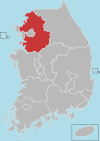Osan
This article needs additional citations for verification. (February 2012) |
Osan
오산시 | |
|---|---|
| Korean transcription(s) | |
| • Hangul | 오산시 |
| • Hanja | 烏山市 |
| • Revised Romanization | Osan-si |
| • McCune-Reischauer | Osan-si |
 Location in South Korea | |
| Country | |
| Region | Sudogwon |
| Administrative divisions | 6 dong |
| Area | |
| • Total | 42.76 km2 (16.51 sq mi) |
| Population (2011) | |
| • Total | 193,892 |
| • Density | 2,824.2/km2 (7,315/sq mi) |
| • Dialect | Seoul |
Osan is a city in Gyeonggi Province, South Korea, approximately 35 km south of Seoul. The population of the city is around 200,000. The local economy is supported by a mix of agricultural and industrial enterprises.
It is famous for one of the largest markets in South Korea, Osan Market, which has been in continuous operation since 1792.[citation needed] The city was the scene of brutal battles with communist forces during the Korean War in 1950 (see Battle of Osan), before being liberated by American forces soon afterwards; there is a statue dedicated to UN forces on the outskirts of the city.
The United States Air Force base named after the city, Osan AB, is not actually located in the city, but is instead 8 km (5 mi) south, in the Songtan section (formerly a separate city) of Pyeongtaek.
Osan Station is a large subway station located in the heart of Osan. It is part of the Seoul Subway Line 1 and the KTX. There is a bus terminal next to the subway station and many buses stop in front of the subway station.
Name
Osan came to be called by its current name in 1914, at the time of a general reorganization of local governments under Japanese rule. At that time it became Osan-myeon, part of Suwon. This name in turn was taken from that of a local stream, the Osancheon. However, prior to the Japanese occupation, the name had been rendered in hanja as 鰲山, meaning "soft-shelled turtle mountain." Because of the complexity of the 鰲 ("o") character, and because crows were abundant in the area, the Japanese changed the name to 烏山, meaning "crow mountain."[citation needed]
Statistics
- based on the data created in dec 2011
| Population: | 193,892 |
| Daily Deaths: | 1.1 |
| Daily Marriage: | 3.7 |
| Daily Divorce: | 0.9 |
| Fires a Day: | 0.3 |
| Students per Teacher: | 29 |
| Number of Cars: | 71,572 |
Sister cities
 Hidaka, Saitama, Japan [1]
Hidaka, Saitama, Japan [1] Ürümqi, People's Republic of China
Ürümqi, People's Republic of China Killeen, Texas, USA
Killeen, Texas, USA Miami, Florida, USA
Miami, Florida, USA
Economy
Kyochon, a fried chicken chain, has its head office in Osan.[2]
See also
References
This article includes a list of references, related reading, or external links, but its sources remain unclear because it lacks inline citations. (November 2009) |
- ^ "International Exchange". List of Affiliation Partners within Prefectures. Council of Local Authorities for International Relations (CLAIR). Retrieved 21 November 2015.
- ^ "Contact." Kyochon. Retrieved on November 3, 2009.
- "오산시의 지명 유래". Retrieved 2006-03-23.


